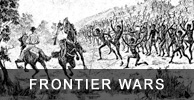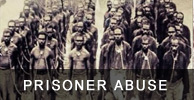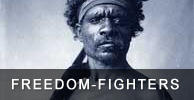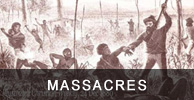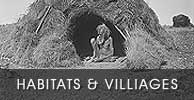War Memorial should recognise the Frontier Wars: Researcher
A researcher, who presented alarming numbers of the deaths in Queensland's Frontier Wars between 1788 and 1930 to the Australian Historical Association, said the estimated figure of 65,180 was "conservative" and could be as high as 115,000. The co-author of a report, historian Professor Raymond Evans, said the calculations were based on official records, witnesses' reports and the number of patrols undertaken by the colonial Queensland government's Native Police.
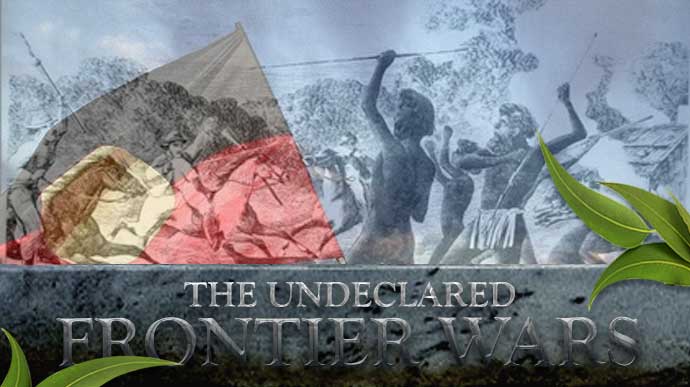
The Undeclared Frontier wars claimed more than 65,000 Aborigines in Queensland
Cameron Atfield Brisbane Times 17 July 2013
New research that has calculated an Aboriginal death toll of more than 65,000 in Queensland alone during the so-called frontier wars has renewed calls for formal recognition at the Australian War Memorial.
But the Australian War Memorial (AWM) in Canberra has dismissed the idea, saying recognition should instead be in the National Museum.

Historian Professor Raymond Evans
Honorary Senior Research Fellow
Centre for Critical and Cultural Studies
University of Queessland
The research, presented to the Australian Historical Association's Conflict in History conference last week at the University of Queensland, estimated 66,680 deaths between 1788 and 1930.
Of those deaths, 65,180 were Indigenous, which is more than six times what was previously thought.
The report's co-author, historian Professor Raymond Evans, said the calculations were based on official records, witnesses' reports and the number of patrols undertaken by the colonial Queensland government's Native Police.
Professor Evans said the 65,180 figure was "conservative" and could be as high as 115,000.
"This is just Queensland – imagine what the nation-wide figure could be," he said.
"If you say it's a war, you at least allow the fact that Aboriginal people fought hard to defend their lands, so you can say they were warriors and they were fighting for their country.
"They were fighting for Australia, for their land."
Professor Evans said the estimated death toll was at least on a par with Australian casualties during World War I.
"The Australian War Memorial should recognise this as a war. It's got such a high death rate, it was fought over a long period of time and it was fought between different communities, different nations, for territory," he said.

Dr Brendan Nelson
Director of the Australian War Memorial
"It's a fight for land and territorial possession and it has many features of warfare and, of course, a huge death rate."
But the apparent reality would be difficult for many Australians to accept, Professor Evans said.
"Often the truth is bitter and the truth is difficult, but unless you can have an honest appraisal of your past you can't move forward with any sense of reality," he said.
" ... You have to read the page before you can turn the page. If we want to turn this page in Australia, we've got to acknowledge it. We've got to accept, as white people, that this was done to Aboriginal people."
Prominent Queensland Indigenous activist Sam Watson said he was not surprised by the high figure and backed the push for recognition in the Australian War Memorial.
"These people were killed, shot, murdered in defence of their homeland, so they have every right to be afforded the recognition and honour due to them, as soldiers killed in the defence of their country," he said.
"Unfortunately, Aboriginal and Torres Strait Islander people have largely oral cultures and oral records, so it's difficult to rely on those records over a number of generations to substantiate actual casualty figures.
"But certainly, (the new research) concurs with the range of figures that we've always worked on."
Mr Watson said he had family ties to the Kalkadoon people of Mt Isa and the Biri Gubba people of central Queensland.
"Both the Biri Gubba and the Kalkadoon fought full-scale wars against the invading soldiers, the colonial forces, over a number of years and large numbers were killed," he said.
"I think it would be great for the surviving community members. It would be a very large thing, particularly around this time of year when we're celebrating NAIDOC, to reflect and look back on the passage of time and the events of that joint journey together."
But a spokeswoman for the Australian War Memorial said its space was reserved for Australians who had died on or as a result of active service, or as a result of "any war or warlike operations" in which Australians had been in active service.
"The mission of the Australian War Memorial does not extend beyond the experience of deployed Australian forces overseas in war and in peace," she said.
"The institution whose mission includes this is the National Museum of Australia.
"All Australians who have served are commemorated at the Australian War Memorial no matter what their ethnicity.
"The stories of Indigenous opposition to European settlement and expansion is one that should be told, but not by the AWM."
The spokeswoman said the AWM's director had acknowledged the "importance" of the frontier conflict in Australian history, but had "pointed out that they should be told at the National Museum of Australia – and this has been agreed to by the National Museum".

